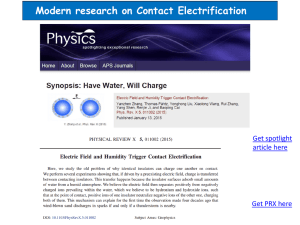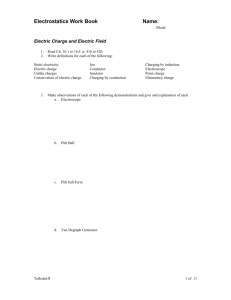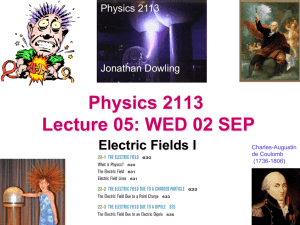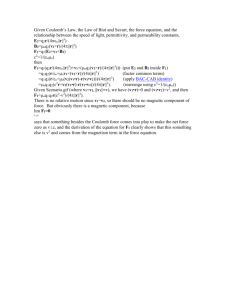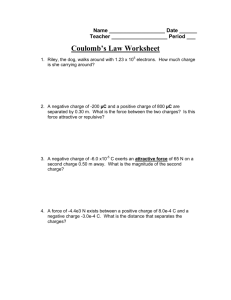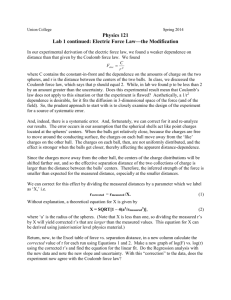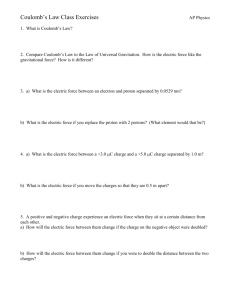Chapter 13 Law of Static Field
advertisement
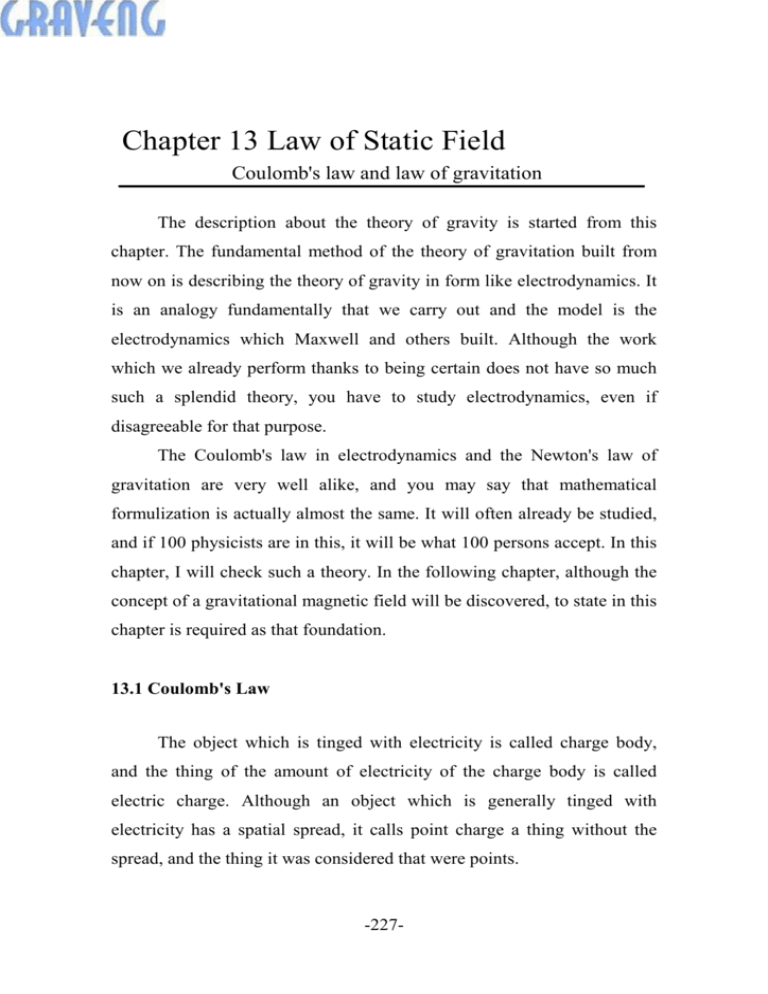
Chapter 13 Law of Static Field Coulomb's law and law of gravitation The description about the theory of gravity is started from this chapter. The fundamental method of the theory of gravitation built from now on is describing the theory of gravity in form like electrodynamics. It is an analogy fundamentally that we carry out and the model is the electrodynamics which Maxwell and others built. Although the work which we already perform thanks to being certain does not have so much such a splendid theory, you have to study electrodynamics, even if disagreeable for that purpose. The Coulomb's law in electrodynamics and the Newton's law of gravitation are very well alike, and you may say that mathematical formulization is actually almost the same. It will often already be studied, and if 100 physicists are in this, it will be what 100 persons accept. In this chapter, I will check such a theory. In the following chapter, although the concept of a gravitational magnetic field will be discovered, to state in this chapter is required as that foundation. 13.1 Coulomb's Law The object which is tinged with electricity is called charge body, and the thing of the amount of electricity of the charge body is called electric charge. Although an object which is generally tinged with electricity has a spatial spread, it calls point charge a thing without the spread, and the thing it was considered that were points. -227- Those with two kind and one call it positive charge, and another tells a minus electric charge to an electric charge. The power committed between electric charges stationary in a vacuum is proportional to the product of two electric charges, and in inverse proportion to the square of both distance. The direction of power is mutually repelled, when the product of an electric charge is positive, and it pays well mutually at the time of negative. However, it shall be considered that an electric charge is point charge. If it writes by a formula, F F Q1Q2 r2 Q Q k r1 2 2 (13.1) F ;Power between two electric charges, Q 1 , Q 2 ;electric charges, k ;Proportionality factor, r ;Distance between electric charges If it writes in vector, F2 k Q1Q2 r 2 r 12 F 1 F 2 k k Q1Q2 r2 r 0 Q1Q2 r 2 r 12 k (13.2) Q2Q1 r 2 r 21 k Q2Q1 r2 r0 (r 12 r 21 ) F 2 ;Power committed to Q 2 , F 1 ;Power committed to Q 1 , r 12 ;The unit vector turned to Q 2 from r 21 ;The unit vector turned to Q 1 from Q1 Q2 r 0 ;The unit vector turned to the right-hand side electric charge from the electric charge of the left-hand side in a formula -228- The direction of the power committed to Q 1 and the direction of the power committed to Q 2 are always opposite irrespective of the combination of the positive/negative of each electric charge. namely, F 1 F 2 (13.3) A relation like a formula (13.1) is called Coulomb's law. Relation between the positive/negative of an electric charge, and the direction of power, Q1 Q2 Q1 Q2 F1 F2 + + + <-- --> - + + - <---> --> <-- + - - --> <-- When the product Q 1 Q 2 of an electric charge is positive, by restitution, it becomes attraction at negative. Although the quantity which becomes a unit for measuring a quantity called an electric charge quantitatively was required, compared with mass etc., a quantity called an electric charge was a comparatively new quantity, and was a unit which does not exist before the Coulomb's law is discovered. In such a case, proportionality factor Optionality is between the units of an electric charge, if a proportionality factor is decided arbitrarily, the unit quantity of an electric charge will be decided, and a proportionality factor will be decided if the unit quantity of an electric charge is decided arbitrarily conversely. Although this combination exists infinitely, two kinds, C (Coulomb) and esu (Oersted), -229- exist in the unit of an electric charge as unit quantity generally used now. The former is a MKS system unit and the latter is a unit of a CGS gauss system. How to call is connected with a scientist's name, respectively. Coulomb is k of a formula (13.1). k 0 1 4 0 8.98755179 10 9 is called a vacuous dielectric constant, It is the quantity 8.85418782 10 12 Oersted is k of a formula (13.1). k1 Considering which [ of these two units ] being a more rational quantity is that it is almost meaningless. For example, the meter which is the most general unit of length does not have a rational reason, and a rational reason is not necessarily in a yard. After all, some someone is the suitably fixed thing and unit quantity does not have a rational reason etc. If it says in the amount of electric charges, some someone collects electric charges suitably, and it will not independently matter even if it claims that the quantity is the unit quantity of an electric charge. If it says by this case, a physical reason etc. did not exist fundamentally to have set with k 8.98755179 10 9 or k 1, but it has only merely decided suitably. However, it is clear that an equation can express briefly depending on how to place a proportionality factor. For example, it becomes unnecessary to be set to 0 1 if referred to as k 1/4, and to define a quantity called the electric flux density described later independently, and could describe an equation more briefly. -230- Moreover, although unit Newton of power is 1N 1kgm/s 2 , this is defined as 1o 0.12345kgm/s 2 etc., and even if o claims that it is a unit of power, it is not independently wrong, for example. However, since calculation becomes troublesome, who adopts such a unit and the wax which dropped off it. The determination of a unit is usually decided historically. The law of gravitation is written to be F G Mm r2 It is this although the proportionality factor G 6.67 10 11 is used. It places with G 1, and if the unit of power and the unit of distance will not be changed, the unit of new mass can be defined. If such a unit is used, the law of gravitation can be written to be F Mm r2 Since it is [ the equation ] briefer to write in this way, nobody lends an ear in the place it was claimed that should change the unit of mass?. If such a thing is accepted, you have to stop all having to repair the literature and the industrial commodity in which the existing law of gravitation and the thing of mass are written. Since nobody wants to do such a troublesome thing, such change is avoided. Moreover, it turns out that it has optionality like how to decide a unit also in this example, as for a physical constant. -231- If it thinks that the units of physics are not someone's suitable ideas and should be determined depending on an eternal physical phenomenon, It is possible to include many physical constants in a unit, and although seldom praised placing with k 8.98755179 10 9 also about the Coulomb's law, if it says for that to be right historically, there will be no language nothing answers back. It is a unit of the electric charge defined suitably physically, and it is good if the magnitude correlation of the amount of electric charges can be compared. If Coulomb's law is used, even if it measures by Coulomb and measures by Oersted, the amount of electric charges can be defined quantitatively. We will adopt the MKS unit system which is a more general unit system. This unit system is because it is convenient also at the point which considers correspondence with the law of gravitation. The Coulomb's law using this unit is set to F Q1Q2 4 0 r 2 r 0 (13.4) 13.2 Electric Field As for the Coulomb's law, in the approximation it was presupposed that is transmitted momentarily, the effect of telling coulomb force is materialized like the law of gravitation. When the electric charge is moving, generally this law is not realized. Stating in this chapter is a law of the approximation which can be regarded as the electric charge not moving. Such a static electric field is called the electrostatic place. -232- If another electric charge q was brought to the surroundings of the electric charge Q the power of following the Coulomb's law works to q. changing of carrying out, and changing also with amounts of electric charges of the electric charge Q even when distance is the same with distance of the electric charge Q and the electric charge q can say the size of the power from the Coulomb's law. This shows that the effect which the electric charge Q does can express as a spatial function. With sizes of an electric charge, how to do the coulomb force to the circumference changes. That is, the situations of an electric field differ. What is necessary is just to consider the power which will be committed to this, when a unit electric charge is brought to one point of an electric field so that distribution of the electric field by the original electric charge may not be disturbed in order to express an electric field quantitatively. I will call this the strength of an electric field. What is necessary is just to convert the power committed to this per unit electric charge, when an infinitesimal electric charge is brought mathematically, very little electric charges and in order to measure the strength of an electric field precisely. The power committed to an infinitesimal electric charge becomes below like a universal gravitation place. E q0 lim Fq q (13.5) It will become below if this is converted per unit electric charge. F qE (13.6) -233- This E is the following from correspondence with a formula (13.4). E Q 4 0 r 2 r 0 (13.7) this E-- the strength of an electric field -- or it is only called the electric field. 13.3 Potential If the concept of the work in physics is given in power and the form of the product of displacement and the power F generally works by B from the section A, the work W is expressed as follows. W A F ds B (13.8) The minus mark which appeared here is an expedient thing determined depending on the coordinate system taken arbitrarily. If a formula (13.6) is substituted for this formula, it will be written as the following. W A qE ds B (13.9) A quantity called the work over a coulomb force place (electric field E) can be defined. The work required for carrying a unit electric charge as a case of this formula of being special is a case where it places with q 1, and it can write it as follows. -234- BA A E ds B (13.10) This BA is called the potential difference to the point Bof the point A. Since a coulomb force place is the same central force as a universal gravitation place, it is a conservative force place and the following is materialized in the static electric field E. rot E 0 The quantity this BA is not based on an intermediate course, but is constant. That is, as an integration way, since an integration way may be taken arbitrarily, supposing it passes along the point O, a formula (13.10) can be written to be the following. BA A E ds A E ds O E ds B O B The formula of integration, AO E ds OA E ds Come out and it is, AO O E ds, BO O E ds A B When it places, BA BO AO (13.11) -235- It can write. If the potential difference to the arbitrary reference points O in an electric field understands this formula, the potential difference for two arbitrary points shows that the difference of the potential difference to the reference point O of each point may be taken. When this reference point should just choose the most expedient good place and makes it the point at infinity, it is convenient. The potential difference with this point at infinity can be written as follows. E ds r (13.12) This is only called potential. This is the potential in electrodynamics. 13.4 Inclination of Potential Potential is a function of space and can consider the inclination to space. Inclination of this potential and the relation of the strength of an electric field are written to be the followings. E grad x i y j z k (13.13) Since the quantity which carried out space integration of the E is , naturally it is E which carried out space differentiation of the , and a formula (13.13) is attached table expression of a formula (13.12). Form like a formula (13.12) is called expression by integration form, and it may be called an expression according expression like a formula (13.13) to differentiation form. -236- 13.5 Electric Charge Distribution Until now, distribution of an electric charge did not have an idea lever about the spread as that it can be considered that is a point. Here, I will become common to continuous electric charge distribution. Since it is clear that the electric charge exists in the spatial place, in order to consider distribution of an electric charge, the volume distribution will be considered. The quantity is called the charge density by the thing of the amount of electric charges in unit volume.This is a spatial scalar function and units are [an electric charge/volume]. If is expressed as a function of x, y, z coordinates, it can be written asx, y, z. The product x, y, zdxdydz of this quantity and the minimum volume dxdydz is the amount of electric charges contained in that minimum volume. If it supposes that the total amount of electric charges contained in the domain V is Q, the minimum volume is written to be dv dxdydz and volume integration of the x, y, zdv is carried out in the domain, the quantity will be the total amount of electric charges. That is, it is the following. Q V dv (13.14) 13.6 Law of Gauss and Electric Flux I will define the quantity which placed 0 of the formula (13.7) with 1. The quantity is called electric flux density and is the following. -237- D Q 4r 2 r 0 (13.15) In a vacuum, it is the following so that clearly from a definition. D 0E (13.16) That Q is in the inside of the closed surface which carried out arbitrary forms like a balloon now, it is a direction perpendicular to a field minimum on the closed surface (it is henceforth called area matter), and a size considers the surface integral of the area vector dS equal to area matter, and the vector D. The surface integral of all closed surfaces is the following. S D dS (13.17) This is called electric flux. As a case of being easy, a closed surface is a ball of the radius r, and when there is Q at the center, since D and dS are parallel, they are the following. D dS DdS cos 0 DdS If it converts per unit area, since this electric flux density D will be Q 4r 2 (called electric flux density in the quantity of electric flux per unit area) and the surface area of a ball will be 4r 2 , the whole electric flux is the following. -238- Q 4r 2 4r 2 Q Therefore, as for electric flux and an electric charge, the quantity is not equally based on the radius of a ball. This is the same as the case of a ball also at electric flux of the whole passing through the closed surface which carried out arbitrary forms. For example, if particles, such as a bullet, imagine that Q is a source to which it is emitted at a fixed rate in all the directions, you can understand intuitively. It is not mathematically difficult. It is because the area of the ingredient an ingredient and the area vectors dS and D cross at right angles is given by an inner product (Fig. 13.1). dS D dS dS cos(D,d S ) Fig. 13.1 Meaning of inner product It follows, S D dS Q (13.18) -239- Moreover, the following relations are obtained from a formula (13.14). S D dS V dv (13.19) it can also be written as the following from a formula (13.16). S 0 E dS V dv (13.20) This relation is called the law of a gauss. If this is written by means of language, the surface integral about the all curved surface side of the electric flux density D passing through a certain closed surface is equal to all the electric charges inside the closed surface. This law extends the Coulomb's law and the law of a gauss and the Coulomb's law are expressions of another form of the same law instead of another physical law. The Coulomb's law is contained in the law of a gauss if a collective expression is used. 13.7 Differentiation Form of Law of Gauss According to the divergence theorem of a gauss, and the formula (11.27), there were the following relations to the arbitrary vectors A. S A dS V div Adv (13.21) From this formula and a formula (13.20), it can be written as the following. -240- V div Edv 1 0 V dv Therefore, the following is obtained. div E E 0 (13.22) This formula is expression by the differentiation form of the law of a gauss. This formula is materialized also in the electric field which is moving. Although like the bullet which continues being radiately emitted in a fixed quantity can be thought whose law of a gauss is , the number of cartridges of the bullet in fixed time is not different from the tank which is standing by the case where it shoots from the case where a bullet is shot with a machine gun, and the tank which is running, for example. If a formula (13.13) is substituted for this formula, it will become the following. div grad 2 2 x 2 2 y 2 2 z 2 0 (13.23) This equation is called equation of poisson. 13.8 Like Electrodynamic Expression of Law of Gravitation The law of the static electric field described until now is applicable to the law of a gravitational field static almost as it is. -241- In consideration of correspondence with the law of a static electric field, I will list the law (law of a universal gravitation place) of a static gravitational field here. (1) The strength of a gravitational field, and the relation of inclination of gravitational potential E g g (13.24) E g ;Strength of a gravitational field, g ;Gravitational potential (2) The law of the gauss in a gravitational field Eg g G0 (13.25) g ;Mass density, G 0 ;The constant of gravitation of another form 1/4G (3) The equation of the poisson in a gravitational field g 2 g G0 (13.26) These things show that the law of a static electric field and the law of a static gravitational field are completely formally the same. However, while electricity consists of elements called two kinds of electric charges of positive/negative, it cannot be overemphasized that it is the difference with decisive consisting of elements called one kind of positive mass by -242- gravity. The law of the gauss in a gravitational field is attached table expression of the law of gravitation, and are all the laws of the gravitational field where the equation of these is static. -243-

